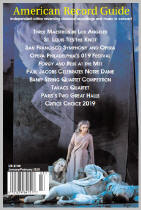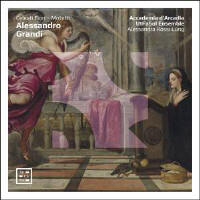Texte paru dans: / Appeared in: |
|
|
Outil de traduction ~ (Très approximatif) |
|
|
Reviewer: William
J. Gatens Alessando Grandi (1590-1630), a younger contemporary of Monteverdi, was an important figure in the application of the Italian baroque Seconda Prattica to sacred texts. He was born in Venice, where he was associated with the churches of San Moise and St Mark’s Basilica, where he obtained his musical education. He was admitted to minor ecclesiastical orders. His extraordinary musical talent led to his admission to the choir of St Mark’s while still in his teens, when the statutory minimum age was 20. It is likely that he studied with Giovanni Croce and was profoundly influenced by the works of Giovanni Gabrieli. Grandi’s earliest motets contain quotations from Gabrieli. In 1609 he left Venice for Ferrara, where he was associated with the Accademia dello Spirito Santo and Accademia degli Intrepidi, producing both sacred and secular music. He returned to Venice and the musical establishment of St Mark’s in 1617 and remained there until 1626. Program annotator Rodolfo Baroncini conjectures that the high pressure and jealousies at St Mark’s, and possibly tension between Grandi and Monteverdi prompted his departure. Grandi appears to have had a talent for attracting the support of nobles and wealthy gentry, and it was through the influence of nobleman Francesco Duodo that he obtained the position of music director at the basilica of Santa Maria Maggiore in Bergamo. Grandi and his family fell victim to the plague there in 1630. His publications consist of 6 collections of secular music and 15 of sacred. This recording draws from eight of the latter. As conductor Alessandra Rossi Lürig points out in a brief note, the motet offered the most promising field for the application of the new declamatory style to sacred texts. Motet texts tended not to be liturgically prescribed, so the genre offered the composer more expressive freedom than the formality of liturgical settings. In Grandi’s works, declamation takes precedence over vocal virtuosity, though there are some exceptions among the pieces recorded here. The motet Factum est Silentium is for the feast of St Michael and All Angels, but most of the music here is not so specific. Much of it has a flavor of vocal chamber music for private devotion. Nearly all of the motets are for two to four solo voices with continuo. Some have obbligato parts, played here by cornetti and sackbuts. The most elaborately scored motet here is the Vesper Psalm Nisi Dominus (Vulgate 126) for 8 voices, 5 wind instruments, and continuo. It makes a suitably exuberant conclusion to the program.
The performances are superb.
The singers and players seem to understand this
music from
the inside, and their technical standard leaves nothing to be desired. In
his day, Grandi was widely considered Monteverdi’s equal. We may stop short
of that, but the present selection demonstrates that his more than 300
surviving works are worthy of serious consideration. | |
|
|
|
|
Cliquez l'un ou l'autre
bouton pour découvrir bien d'autres critiques de CD |
|




